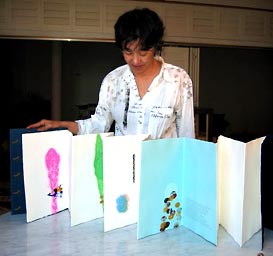 Here's a poem by a poet, Mei-Mei Berssenbrugge, whom I first encountered as an undergraduate (thanks to Ishmael Reed, who invited her to campus and urged us all to go hear her read). I think I said hello, but was too shy to say much else beyond offering praise for poems, which were unlike anything I'd seen up to that point.
Here's a poem by a poet, Mei-Mei Berssenbrugge, whom I first encountered as an undergraduate (thanks to Ishmael Reed, who invited her to campus and urged us all to go hear her read). I think I said hello, but was too shy to say much else beyond offering praise for poems, which were unlike anything I'd seen up to that point.Her sensuous, prismatic collection The Heat Bird (Burning Deck) was one of the first books of poetry I bought to read for pleasure as an adult, rather than for a class, and though I enjoyed it almost immediately, it took me years to fathom what was going on in it, to decipher--as Sylvia Wynter would say--what it was doing, rather than to interpret it as I'd been trained to do.
I finally got to chat with Berssenbrugge at length last year when she came to read at the university, and got to spend a little time with her and another colleague, Dorothy Wang, just talking about poetry. She wanted to see the lake (Michigan), so Dorothy and I walked with her towards the shore in Evanston, and it was then that I learned that she was married to one of the artists she'd collaborated with in the past, Richard Tuttle. I've nabbed the poem excerpt below from the Dia Center for the Art's poetry pages, though it also appears on this wonderful page, Intercapillary Space (from which I've borrowed the photo of Berssenbrugge above), which has lots of great links on her and her work. She has a new book out, entitled I Love Artists (California), which I am going to get as soon as I can.
From THE RETIRED ARCHITECT
3
I tried to complete a life circumstance like a building, loose in space on
used land.
I made a shape against sky on flat land like a cut in the weeds, but I got
bored and didn't finish.
Concrete surfaces need support, and my illness made calculations difficult,
shadows fell like hinges on erasures.
This site is riddled with plastic wood panelling, plastic ducks and
discarded coach lamps.
The iconography doesn't ethically correspond to its cut up and eroded
state.
I make something which as it changes and falls apart, offers no clues to
itself before, as if all shots were mobility frames.
Small daisies grow in the cut, preserving the shape.
Physical significance becomes an area lacking objects, a changing surface
as limit, like the surface and mass of a lake.
Nothing was completed, but there are a lot of sketches.
Actually, I designed two bungalows: the gold leaf, and one later, because
I had missed something.
Gilding was decoration, irrelevant to her private space.
Now, when my work expresses loss or failure, I no longer say, get rid of
that.
© 1999






Tuttle is having a major show at the Des Moines (IA) Art Center just now, so I think. WSD
ReplyDeleteThanks for the heads up, WSD.
ReplyDelete